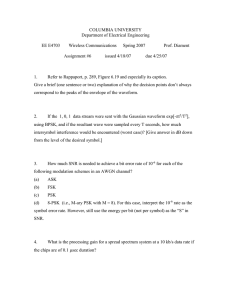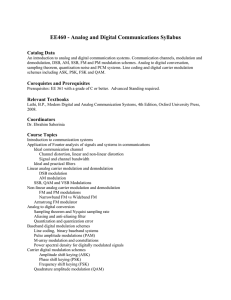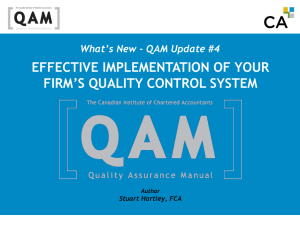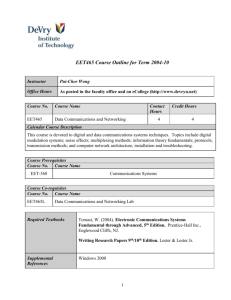Research Journal of Applied Sciences, Engineering and Technology 6(20): 3910-3915,... ISSN: 2040-7459; e-ISSN: 2040-7467
advertisement
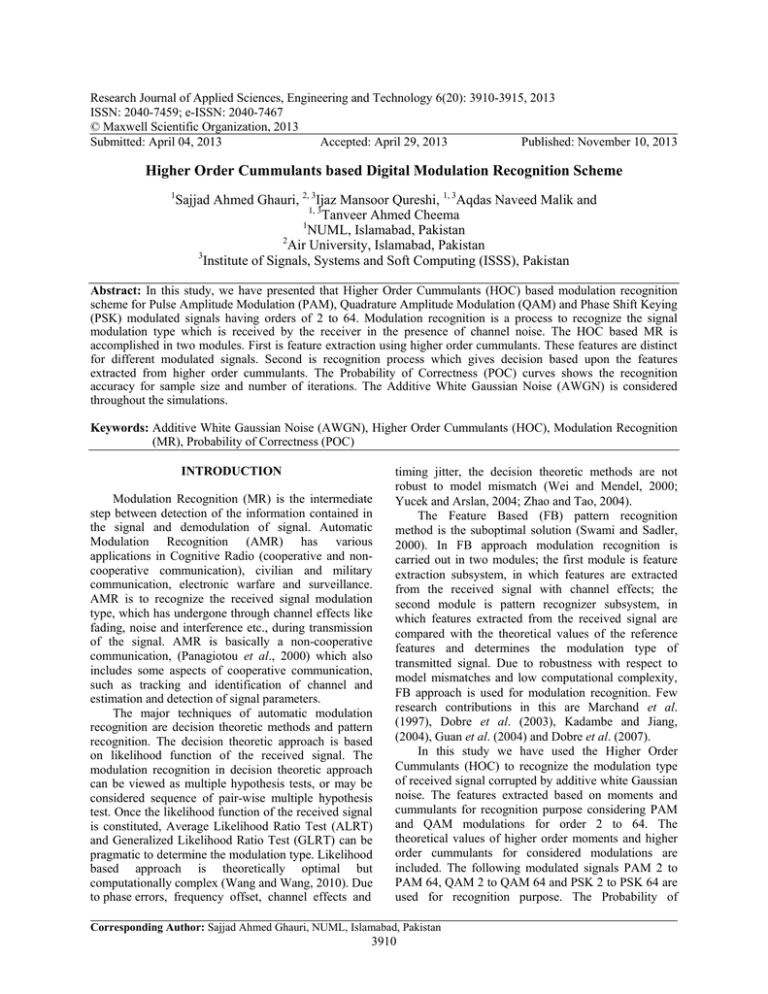
Research Journal of Applied Sciences, Engineering and Technology 6(20): 3910-3915, 2013
ISSN: 2040-7459; e-ISSN: 2040-7467
© Maxwell Scientific Organization, 2013
Submitted: April 04, 2013
Accepted: April 29, 2013
Published: November 10, 2013
Higher Order Cummulants based Digital Modulation Recognition Scheme
1
Sajjad Ahmed Ghauri, 2, 3Ijaz Mansoor Qureshi, 1, 3Aqdas Naveed Malik and
1, 3
Tanveer Ahmed Cheema
1
NUML, Islamabad, Pakistan
2
Air University, Islamabad, Pakistan
3
Institute of Signals, Systems and Soft Computing (ISSS), Pakistan
Abstract: In this study, we have presented that Higher Order Cummulants (HOC) based modulation recognition
scheme for Pulse Amplitude Modulation (PAM), Quadrature Amplitude Modulation (QAM) and Phase Shift Keying
(PSK) modulated signals having orders of 2 to 64. Modulation recognition is a process to recognize the signal
modulation type which is received by the receiver in the presence of channel noise. The HOC based MR is
accomplished in two modules. First is feature extraction using higher order cummulants. These features are distinct
for different modulated signals. Second is recognition process which gives decision based upon the features
extracted from higher order cummulants. The Probability of Correctness (POC) curves shows the recognition
accuracy for sample size and number of iterations. The Additive White Gaussian Noise (AWGN) is considered
throughout the simulations.
Keywords: Additive White Gaussian Noise (AWGN), Higher Order Cummulants (HOC), Modulation Recognition
(MR), Probability of Correctness (POC)
INTRODUCTION
Modulation Recognition (MR) is the intermediate
step between detection of the information contained in
the signal and demodulation of signal. Automatic
Modulation Recognition (AMR) has various
applications in Cognitive Radio (cooperative and noncooperative communication), civilian and military
communication, electronic warfare and surveillance.
AMR is to recognize the received signal modulation
type, which has undergone through channel effects like
fading, noise and interference etc., during transmission
of the signal. AMR is basically a non-cooperative
communication, (Panagiotou et al., 2000) which also
includes some aspects of cooperative communication,
such as tracking and identification of channel and
estimation and detection of signal parameters.
The major techniques of automatic modulation
recognition are decision theoretic methods and pattern
recognition. The decision theoretic approach is based
on likelihood function of the received signal. The
modulation recognition in decision theoretic approach
can be viewed as multiple hypothesis tests, or may be
considered sequence of pair-wise multiple hypothesis
test. Once the likelihood function of the received signal
is constituted, Average Likelihood Ratio Test (ALRT)
and Generalized Likelihood Ratio Test (GLRT) can be
pragmatic to determine the modulation type. Likelihood
based approach is theoretically optimal but
computationally complex (Wang and Wang, 2010). Due
to phase errors, frequency offset, channel effects and
timing jitter, the decision theoretic methods are not
robust to model mismatch (Wei and Mendel, 2000;
Yucek and Arslan, 2004; Zhao and Tao, 2004).
The Feature Based (FB) pattern recognition
method is the suboptimal solution (Swami and Sadler,
2000). In FB approach modulation recognition is
carried out in two modules; the first module is feature
extraction subsystem, in which features are extracted
from the received signal with channel effects; the
second module is pattern recognizer subsystem, in
which features extracted from the received signal are
compared with the theoretical values of the reference
features and determines the modulation type of
transmitted signal. Due to robustness with respect to
model mismatches and low computational complexity,
FB approach is used for modulation recognition. Few
research contributions in this are Marchand et al.
(1997), Dobre et al. (2003), Kadambe and Jiang,
(2004), Guan et al. (2004) and Dobre et al. (2007).
In this study we have used the Higher Order
Cummulants (HOC) to recognize the modulation type
of received signal corrupted by additive white Gaussian
noise. The features extracted based on moments and
cummulants for recognition purpose considering PAM
and QAM modulations for order 2 to 64. The
theoretical values of higher order moments and higher
order cummulants for considered modulations are
included. The following modulated signals PAM 2 to
PAM 64, QAM 2 to QAM 64 and PSK 2 to PSK 64 are
used for recognition purpose. The Probability of
Corresponding Author: Sajjad Ahmed Ghauri, NUML, Islamabad, Pakistan
3910
Res. J. Appl. Sci. Eng. Technol., 6(20): 3910-3915, 2013
C40 = M40 − 3M20 2 =
cumm{y(n), y(n), y(n), y(n)}
Correctness (POC) curves are simulated, based on
Signal to Noise Ratio (SNR), number of iterations and
sample size. The simulation results using HOC for the
considered modulated signals show that high
recognition rate is achieved at low SNR. The
cummulants based tree structure for recognition of PSK
signals is briefly presented.
C41 = M40 − 3M20 M21 =
cumm{y(n), y(n), y(n), y ∗ (n)}
C42 = M42 − |M20 |2 − 2M21 =
cumm{y(n), y(n), y ∗ (n), y ∗ (n)}
SYSTEM MODEL AND FEATURES USED
C60 = M60 − 15M20 M40 + 30M20 3 =
cumm{y(n), y(n), y(n), y(n), y(n), y(n)}
System model: Figure 1 shows the system model. The
generalized expression for signal received is given by:
𝑟𝑟(𝑛𝑛) = 𝑠𝑠(𝑛𝑛) + 𝑦𝑦(𝑛𝑛)
(1)
C61 = M61 − 5M21 M40 − 10M20 M41
+30M20 2 M21 = cumm
{y(n), y(n), y(n), y(n), y(n), y ∗ (n)}
where,
𝑟𝑟(𝑛𝑛) : Complex baseband envelop of received signal
𝑦𝑦(𝑛𝑛) : The additive white guassian noise
𝑠𝑠(𝑛𝑛) : Given by:
𝑗𝑗 =∞
𝑠𝑠(𝑛𝑛) = 𝐾𝐾𝑒𝑒 𝑖𝑖(2𝜋𝜋𝑓𝑓𝑜𝑜 𝑛𝑛𝑛𝑛 +𝜃𝜃𝑛𝑛 ) ∑𝑗𝑗 =−∞ 𝑠𝑠(𝑙𝑙)
ℎ(𝑛𝑛𝑛𝑛 − 𝑗𝑗𝑗𝑗 + 𝜖𝜖 𝑇𝑇 𝑇𝑇)
(6)
(7)
(8)
(9)
C62 = M62 − 6M20 M42 − 8M21 M41 − M22 M40
+6M20 2 M22 + 24M21 2 M22 = cumm
{y(n), y(n), y(n), y(n), y ∗ (n), y ∗ (n)}
(10)
(2)
where,
𝑠𝑠(𝑙𝑙) : Input symbol sequence which is drawn from set
of M constellations of known symbols and it is
not necessary that symbols are equi-probable
K : Amplitude of signal
𝑓𝑓𝑜𝑜 : Frequency offset constant
T
: Symbol spacing
𝜃𝜃𝑛𝑛 : The phase jitter which varies from symbol to
symbol
ℎ(… ): Channel effects
𝜖𝜖 𝑇𝑇 : The timing jitter
(5)
C63 = M63 − 9M21 M42 + 12M21 3 − 3M20 M43
−3M22 M41 + 18M20 M21 M22 = cumm
{y(n), y(n), y(n), y ∗ (n), y ∗ (n), y ∗ (n)}
(11)
C80 = M80 − 35M40 2 − 28M60 M20 + 420M40
M20 2 − 630M20 4 = cumm
{y(n), y(n), y(n), y(n), y(n), y(n), y(n), y(n)} (12)
𝐶𝐶84 = 𝑀𝑀84 − 16𝐶𝐶63 𝐶𝐶21 + |𝐶𝐶40 |2 − 18𝐶𝐶42 2
−72𝐶𝐶42 𝐶𝐶21 2 − 24𝐶𝐶21 4 = 𝑐𝑐𝑐𝑐𝑐𝑐𝑐𝑐
𝑦𝑦(𝑛𝑛), 𝑦𝑦(𝑛𝑛), 𝑦𝑦(𝑛𝑛),
�
�
𝑦𝑦(𝑛𝑛), 𝑦𝑦 ∗ (𝑛𝑛), 𝑦𝑦 ∗ (𝑛𝑛), 𝑦𝑦 ∗ (𝑛𝑛), 𝑦𝑦 ∗ (𝑛𝑛)
(13)
Features used: As Cummulants are made up of
moments, so various moments have been used as
features. For the complex valued stationary random
process 𝑟𝑟(𝑛𝑛), Cummulants of 2nd, 4th, 6th and 8th order
have the following definitions:
𝑀𝑀𝑝𝑝𝑝𝑝 stands for moments of received signal and it is
given:
(3)
Feature values based on moments and cummulants:
The theoretical values of Moments and Cummulants
which were used for various signal constellations of
𝐶𝐶20 = 𝐸𝐸[𝑦𝑦 2 (𝑛𝑛)] = 𝑐𝑐𝑐𝑐𝑐𝑐𝑐𝑐{𝑦𝑦(𝑛𝑛), 𝑦𝑦(𝑛𝑛)}
C21 = E[|y(n)|2 ] = cumm{y(n), y ∗ (n)}
(4)
Fig. 1: The system model
3911
𝑀𝑀𝑝𝑝𝑝𝑝 = 𝐸𝐸[𝑦𝑦(𝑘𝑘)𝑝𝑝−𝑞𝑞 𝑦𝑦 ∗ (𝑘𝑘)𝑞𝑞 ]
(14)
Res. J. Appl. Sci. Eng. Technol., 6(20): 3910-3915, 2013
Table 1: Theoretical values of moments of different modulation types
PSK
PSK 2
PSK 4
M20
1
0
M21
1
1
M40
1
1
M41
1
0
M42
1
1
M60
1
0
M61
1
1
M63
1
1
M80
1
1
M84
1
1
QAM
QAM 2
QAM 4
M20
1
0
M21
2
0
M40
2
1
M41
1
0
M42
0
7
M60
0
0
M61
1
8
M63
1
3
M80
0.8
0.9
M84
1
2.5
PAM
PAM2
PAM 4
M20
1
5
M21
2
1
M40
2
1
M41
1
40
M42
0
47
M60
0
0
M61
1
358
M63
1
14
M80
0
0
M84
1
40
PSK 8
0
1
0
0
1
0
0
1
1
0
QAM 8
4
1
1
0
1.20
0
1.18
1.80
1.50
2.90
PAM 8
21
1
1
769
861
0
33203
123
0
769
PSK 16
0
1
0
0
1
0
0
1
0
1
QAM 16
0
1
1
0
1.29
0
1.32
1.96
2.20
3.12
PAM 16
85
1
1
12835
14444
0
2294370
1012
0
12835
Table 2: Theoretical values of cummulants of different modulation types
PSK
PSK2
PSK4
PSK8
C20
1
0
0
C21
1
1
1
C40
2
1
0
C41
2
0
0
C42
2
1
1
C60
31
4
0
C63
13
4
4
C80
350
35
0
C84
163
34
34
QAM
QAM 2
QAM 4
QAM 8
C20
1
0
4
C21
1
1
1
C40
2
1
1
C41
2
0
1
C42
2
1
1
C60
31
0
0
C63
13
1.96
2.2
C80
350
13.60
13.5
C84
163
13.60
13.5
PAM
PAM2
PAM 4
PAM 8
C20
1
5
21
C21
1
5
21
C40
2
1
1
C41
2
1
1
C42
2
1
1
C60
31
2210
139244
C63
13
707
52226
C80
350
402993
113587175
C84
163
44060
12929717
interest are given in Table 1 and 2. The values are
obtained by calculating the ensemble averages under
noise free channel conditions.
In Table 1, the computed values of moments of
PSK, QAM and PAM with orders 2 to 64 are listed.
The moments (row wise) M 21, M 42 and M 63 are
same for all orders of PSK modulated signals. The
moments M 20, M 41 and M 60 are also same for all
orders of PSK modulated signals. The moment M 60
has same value for all orders of QAM modulated
signals? Also all moments for PSK 2 have same
constant value i.e., 1.
PSK16
0
1
0
0
1
0
4
0
34
QAM 16
0
1
1
0
1
0
2
13
13
PAM 16
85
85
1
1
1
9574215
3636415
32331650963
3693480387
PSK 32
0
1
0
0
1
0
0
1
0
0
QAM 32
0
0
0
0
1.32
0
1.30
2
2
3.50
PAM 32
344
1
1
211795
237102
0
154364560
8274
0
211795
PSK32
0
1
0
0
1
0
4
0
34
QAM 32
0
1
0
0
1
0
1.9
12
12
PAM 32
337
337
1
1
1
605695009
230197704
8152670391483
931687158728
PSK 64
0
1
0
0
1
0
0
1
0
0
QAM 64
1
0
1
0
1.38
0
1.29
2.22
1.92
3.96
PAM 64
1356
1
1
3327731
3678478
0
9741354452
65013
0
3327731
PSK64
0
1
0
0
1
0
4
0
34
QAM 64
0
1
1
0
1
0
1.8
11
11
PAM 64
1368
1368
1
1
1
40748052374
15363424446
2206949690426600
252221335666583
In Table 2, the computed values of cummulants of
PSK, QAM and PAM with orders 2 to 64 are listed.
The cummulants C 21and C 42 are same value for all
orders of PSK and QAM modulated signals.
SIMULATION RESULTS
The recognition of PAM and QAM modulated
signals in the presence of additive white Gaussian noise
is evaluated here. The modulated signals considered
here is PAM 2, PAM 4, PAM 8, PAM 16, PAM 32,
PAM64 and QAM 2, QAM 4, QAM8, QAM 16, QAM
3912
Res. J. Appl. Sci. Eng. Technol., 6(20): 3910-3915, 2013
Table 3: The correct rate of recognition of PAM and QAM under
different SNR
SNR in dB
-------------------------------------------------------------------5
0
5
10
15
20
PAM
PAM2
80
95
100
100
100
100
PAM4
90
100
100
100
100
100
PAM8
89
100
100
100
100
100
PAM16
91
100
100
100
100
100
PAM32
90
100
100
100
100
100
PAM64
90
100
100
100
100
100
QAM
QAM2
90
95
100
100
100
100
QAM4
80
100
100
100
100
100
QAM8
90
100
100
100
100
100
QAM16
100
100
100
100
100
100
QAM32
80
100
100
100
100
100
QAM64
90
100
100
100
100
100
32, QAM 64. Table 3 shows the simulation results of
correct recognition of modulated signals using the
higher order Cummulants features under different SNR.
The recognition of PAM and QAM modulated signals
are acceptable above -5 dB. As SNR increases from -5
to 20 dB, the correct rate of recognition also increases,
while at SNR = 0 dB the correct rate of recognition
reaches 100%.
For example considering the modulated signal
PAM2; the graphical representation of the probability
of correctness curve for varying SNR is shown in
Fig. 2. The probability of correctness gradually
increases with the increase in SNR. The probability of
correctness approaches 1 at SNR = -2 dB.
For example considering the modulated signal
PAM4; the graphical representation of the probability
Fig. 2: POC curves for the varying SNR
Fig. 3: POC curves for the varying sample size
3913
Res. J. Appl. Sci. Eng. Technol., 6(20): 3910-3915, 2013
of correctness curves for varying sample size are shown
in Fig. 3. When the sample size is small (N = 10), the
probability of correctness is approximately 0.8 for SNR
= 5 dB. When sample size is increased (N = 100), the
probability of correctness is approximately 1 for SNR =
-1 dB. When the sample size is further increased (N =
1000), the probability of correctness is approximately 1
for SNR = -3 dB.
For example considering the modulated signal
QAM8; the graphical representation of the probability
of correctness curves for different numbers of iterations
are shown in Fig. 4. When the number of iterations is
small (K = 100), the probability of correctness is
approximately 1 for SNR = -1 dB. When number of
iterations is increased (K = 1000), the probability of
correctness is approximately 1 for SNR = -3 dB. When
the number of iterations is further increased (K = 2000),
the probability of correctness is approximately 1 for
SNR = -4 dB.
The recognition of PSK modulated signals are
shown in tree diagram in which only two Cummulants
are used for classifications of PSK modulated signals. If
|C60| <31, the PSK 4, PSK 8, PSK 16, PSK 32, PSK 64
are in one class and second class is PSK2. If |C80| <35,
the PSK 8, PSK 16, PSK 32, PSK 64 are in one class
and PSK 4 is in one class. The higher order
Cummulants for PSK 8, PSK 16, PSK 32 and PSK 64
are same so the Cummulants are not used for the
recognition of this subclass of PSK modulated signals
PSK 8, PSK 16, PSK 32 and PSK 64. The Fig. 5 shows
the tree structure for PSK modulated sequence
recognition using higher order Cummulants and
moments.
Fig. 4: POC curves for the different number of iterations
Fig. 5: Tree structure for PSK signals recognition under AWGN channel
3914
Res. J. Appl. Sci. Eng. Technol., 6(20): 3910-3915, 2013
CONCLUSION
In this study, the characteristics of the cumulative
amount of the modulated signals were analyzed. The
paper chooses the HOS of the signal in which higher
order moments and higher order cummulants are used
for the recognition purpose. The recognition of PAM
and QAM signals are done using decision rule, in which
probability of correctness is based on a Likelihood ratio
test which gives high recognition performance. The
PSK signals recognition is done using tree diagram.
Through simulation it is showed that the recognition
process is correct. The channel is chosen to be Gaussian
white noise channel.
REFERENCES
Dobre, O.A., Y. Bar-Ness and W. Su, 2003. Higherordercycliccummulants for high order modulation
classification. Proc. IEEE MILCOM, 1: 112-117.
Dobre, O.A., A. Abdi, Y. Bar-Ness and W. Su, 2007.
Survey of automatic modulation classification
techniques: Classical approaches and new trends.
IEEE Commun., 1(2): 137-156.
Guan, H.B., C.Z. Ye and X.Y. Li, 2004. Modulation
classification based on spectrogram. Proceeding of
the International Conference on Machine Learning
and Cybernetics, pp: 3551-3556.
Kadambe, S. and Q. Jiang, 2004. Classification of
modulation of signals of interest. Proceeding of the
11th IEEE Digital Signal Digital Signal Processing
Workshop and the 3rd IEEE Signal Processing
Education Workshop, pp: 226-230.
Marchand, P., C.L. Martret and J.L. Lacoume, 1997.
Classification of linear modulations by a
combination of different orders cyclic cumulants.
Proceedings of the IEEE Signal Processing
Workshop on Higher-Order Statistics, pp: 47-51.
Panagiotou, P., A. Anastasopoulos and A. Polydoros,
2000. Likelihood ratio tests for modulation
classification. Proceeding of the 21st Century
Military Communications Conference (MILCOM),
2: 670-674.
Swami, A. and B.M. Sadler, 2000. Hierarchical digital
modulation classification using cummulants. IEEE
T. Commun., 48(3): 416-429.
Wang, F. and X. Wang, 2010. Fast and robust
modulation classification via KolomogorovSmirnov test. IEEE T. Commun., 58(8):
2324-2332.
Wei, W. and J.M. Mendel, 2000. Maximum-likelihood
classification
for
digital
amplitude-phase
modulations. IEEE T. Commun., 48(2):
189-193.
Yucek, T. and H. Arslan, 2004. A novel suboptimum maximum- likelihood modulation
classificationalgorithm for adaptive OFDM
systems. Proceeding of the IEEE Wireless
Communications and Networking Conference, 2:
739-744.
Zhao, Z. and L. Tao, 2004. A MPSK modulation
classification method based on the maximum
likelihood criterion. Proceeding of the 7th
International Conference on Signal Processing, 2:
1805-1808.
3915
